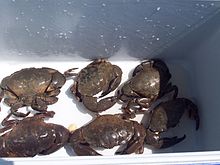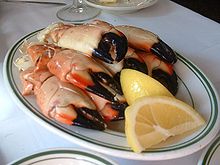- Florida stone crab
-
Florida stone crab 
Scientific classification Kingdom: Animalia Phylum: Arthropoda Subphylum: Crustacea Class: Malacostraca Order: Decapoda Infraorder: Brachyura Family: Menippidae Genus: Menippe Species: M. mercenaria Binomial name Menippe mercenaria
(Say, 1818)The Florida stone crab, Menippe mercenaria, is a crab found in the western North Atlantic, from Connecticut to Belize, including Texas, the Gulf of Mexico, Cuba and the Bahamas that is widely caught for food.
Contents
Description
The stone crab's carapace is 5 to 6.5 inches (130 to 170 mm) long and about 5 in (130 mm) wide in larger specimens. They are brownish red with gray spots and a tan underside, and have large and unequally-sized chelae (claws) with black tips. In addition to the usual sexual dimorphism exhibited by crabs, the female Florida stone crabs have a larger carapace than males of a similar age, and males generally have larger chelae than females.
Ecology
Florida stone crabs prefer the bottoms of bays, grass flats, oyster reefs, and rock jetties where they can burrow or find refuge from predators. Juveniles do not usually dig burrows, but instead hide among rocks or in seagrass beds. It is dark brownish-red with gray interspersed. The claws are hinged, very dark, and banded with red and yellow. Adult Florida stone crabs make burrows in mud or sand below the low tide line, lying in wait for prey.
Florida stone crabs prefer to feed on oysters and other small mollusks, polychaete worms, and other crustaceans. They will also occasionally eat seagrass and carrion. Predators that feed on stone crabs include horse conch, grouper, sea turtles, cobia, octopuses, and humans.[1]
Sexual maturity is reached at one year. Their long spawning season lasts all spring and summer, during which time females produce 500,000 to 1 million eggs. The larvae go through six stages in about 36 days before emerging as juvenile crabs. Their lifespan is seven to eight years.
The male Florida stone crab must wait for the female to molt her exoskeleton before they can mate. After mating, the male will stay to help protect the female for several hours to several days. The female will spawn four to six times each season.
The Florida stone crab loses its limbs easily to escape from predators or tight spaces, but their limbs will grow back. When a claw is broken such that the diaphragm at the body/claw joint is left intact, the wound will quickly heal itself and very little blood is lost. If, however, the claw is broken in the wrong place, more blood is lost and the crab's chances of survival are much lower. It only takes about one year for the claw to grow back to its normal size. Each time the crab molts, the new claw grows larger.
The larger of the two claws is called the "crusher claw". The smaller claw is called the "pincer claw". If the larger crusher claw is on the right side of the crab's body, the crab is "right-handed". If the crusher claw is on the left side of the crab's body, it is "left-handed". Since crabs' eyes are on stalks, they can see 360°. A large crab claw can weigh up to half a pound.
The crab only molts at night or in night-like conditions due to the crab being extremely vulnerable to predators without the protection of its shell. If the crab is becoming too large for its shell and the sun is up, the crab releases a hormone from a gland located on one of their eye stalks called the x-organ. This hormone prevents the crab from molting from its shell until it finds a safe place to molt or it has become dark enough outside to molt in safety.
Fishery
The Florida stone crab is usually fished near jetties, oyster reefs or other rocky areas, just as for blue crabs. The bodies of these crabs are relatively small and so are rarely eaten, but the claws (chelae), which are large and strong enough to break an oyster's shell, are considered a delicacy. Harvesting is accomplished by removing one or both claws from the live animal and returning it to the ocean where it can regrow the lost limb(s). To be kept, claws must be 2.75 inches (70 mm) long, measured from the tips of the immovable finger to the first joint. However, mortality rates are 47% for doubly-amputated crabs and 28% for single amputees.[2] Florida stone crabs are legal for harvest from October 15 until May 15.[3]
To prevent the meat from sticking to the shells, stone crab claws are cooked immediately before being chilled.
The Monterey Bay Aquarium.org has given the Florida Stone Crab fishery its highest rating of "Best Choice" for maintaining high fishing standards and working hard to keep the Stone Crab a viable fishery. Best Choice is given only to fisheries they recommend for consumption.
Notes
External identifiers for Florida stone crab EOL 1021778 ITIS 98811 NCBI 6781 WoRMS 422070 Also found in: GBIF - ^ NOAA - Summary Table of Stone Crab Life History
- ^ Davis GE, Baughman DS, Chapman JD, MacArthur D and Pierce AC (1978) "Mortality Associated with Declawing Stone Crabs, Menippe mercenaria" US National Park Service, Report T-522.
- ^ Florida Fish and Wildlife Conservation Commission - Recreational Stone Crabbing Information
References
- Florida Stone Crabs NOAA FishWatch. Updated 3 May 2011. Retrieved 7 May 2011.
- Florida Stone Crab Ecology University of Florida
- Stone Crab Research Florida Fish and Wildlife Conservation Commission.
Further reading
- Nicolaas Mink (2006). "Selling the storied stone crab. Eating, ecology, and the creation of South Florida culture". Gastronomica 6 (4): 32–43. doi:10.1525/gfc.2006.6.4.32.
Categories:- Eriphioidea
- Edible crustaceans
- Commercial crustaceans
- Crustaceans of the Atlantic Ocean
- Animals described in 1818
Wikimedia Foundation. 2010.

